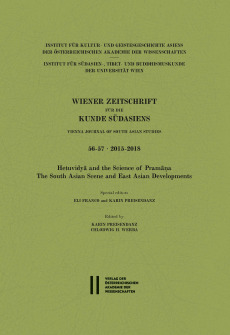Wiener Zeitschrift für die Kunde Südasiens, Band 56–57 (2015–2018) ‒ Vienna Journal of South Asian Studies, Vol. 56‒57 (2015‒2018)
Vienna Journal of South Asian Studies Volume 56–57 (2015–2018). Hetuvidyā and the Science of Pramāṇa. The South Asian Scene and East Asian Developments. Special editors Eli Franco and Karin Preisendanz
Herausgegeben von Eli Franco, Herausgegeben von Institut für Kultur- und Geistesgeschichte Asiens der ÖAW, Herausgegeben von Institut für Südasien-, Tibet- und Buddhismuskunde der Universität Wien, Redaktion: Alexandra Scheuba, Herausgegeben von Chlodwig Werba, Herausgegeben von Karin Preisendanz
Serie: Wiener Zeitschrift für die Kunde Südasiens und Archiv für Indische PhilosophieThe “Wiener Zeitschrift für die Kunde Südasiens / Vienna Journal of South Asian Studies” was founded in 1957 by Erich Frauwallner. The journal was then published jointly by the Department of Indology of the University and the Committee for the Languages and Cultures of South and East Asia (Kommission für Sprachen und Kulturen Süd- und Ostasiens) of the ÖAW, which was the forerunner of the Academy’s Institute for the Intellectual and Cultural History of Asia (Institut für die Kultur- und Geistesgeschichte Asiens, founded in 1991) and has been established at Frauwallner’s initiative in 1956.
This volume contains papers by S. Katsura, S. Moriyama, H. Lasic, E. Steinkellner, J. Taber, L. McCrea, E. Franco, M. Tang and J. Zamorski, based on their contributions to the panel “Pramāṇa across Asia: India, China, Korea, Japan” held at the XVIIth Congress of the International Association of Buddhist Studies at the University of Vienna, August 18–23, 2014. The purpose of the panel was to draw attention to the issue of the transition of Buddhist dialectics, logic and epistemology from South to East Asia and to advance understanding of this process, which – compared to the transmission of these branches of Buddhist learning to Tibet – has been relatively understudied, at least in scholarship in European languages. Inasmuch as the selected papers present foundational new research on crucial points and larger issues, the volume should spark renewed interest in the exploration of the wide-ranging tradition of Chinese Hetuvidyā, before its South Asian backdrop and beyond.

